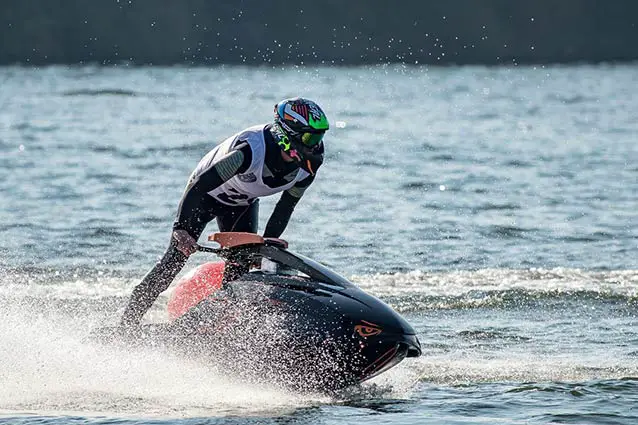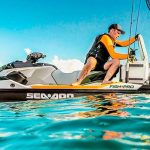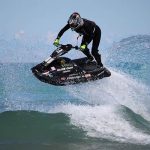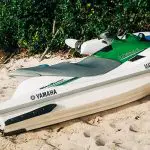It used to be that modifying a personal watercraft for enhanced performance was both relatively simple and reasonably affordable.
We’d usually start with the simplest way to achieve greater acceleration with a more aggressive scoop intake grate. While this did provide the intended result, it generally did cut the top speed a bit due to more hull drag.
So we’d counter that byproduct by “regearing” with a variable pitch impeller. A variable pitch impeller has differing angles, a curve, that theoretically offers the best of both worlds. Think of it not so much as the transmission in your car, but the final drive ratio. A lower geared final drive, ala the fabled 4:10 gears of a late 60s muscle car, is great for acceleration but terrible for fuel mileage and top speed. That’s why most cars of that era came with something more akin to a 3:23 rear, giving up some jump from a dead stop but also substantially reducing engine rpm at highway speed.
Then we’d move on to the engine bay, fitting bulbous chrome expansion chambers. Swap out the 36mm carbs for maybe a pair of 40s. High compression pistons, maybe.
Expansion chambers? Bigger carburetors? That’ll have the kids’ eyes rolling – whoever heard of these ancient things? – so let’s move on.
Contents
More Performance in the Modern Age
While interior engine modifications such as high-compression pistons were pretty manageable for most shade-tree mechanics back in the two-stroke days, more modern four-stroke engines – and especially those equipped with complex intercooled supercharging systems and the like – are exponentially more complicated to get inside of.
Further, within the limitations of common pump gas as fuel, most manufacturers have already pushed compression numbers to the near limit. It’s also no longer simply a question of piston dome to cylinder head distance and squish area being correct.
Now, performance cams and valves are largely standard, and pushing your luck with clearances can have grievous results
Therefore, I’m going to stick to easily installed external modifications for the scope of this article. And, not only are these modifications relatively easy to install, but they also will not require permanent changes to be made to your craft. All are reversible should you disagree with the results or wish to return the PWC to its original form for resale.
Removing Artificial Limitations
For a great many performance watercraft, it’s not the engine output that is limiting performance, but rather the ignition system enforcing the unspoken but much spoken manufacturers’ hand-shake agreement not to exceed 67 mph.
Most high-end watercraft are capable of easily blowing through that artificial barrier with the nanny-speed limiter defeated.
The easiest and most affordable way to gain top-end performance for your personal watercraft is with a speed control override module like the ones offered by Riva Racing.
These are super simple to install plug-and-play modules that will likely increase your top speed by five miles per hour or so even if your watercraft is otherwise completely stock and standard. They simply defeat the restrictive speed control installed by the factory.
And, if you are to go any further down the performance modification path, you’re whistling in the wind without removing the restrictor. You can add all the horsepower you can afford, but if your ignition system says “no” you might gain acceleration, but top speed will remain the same.
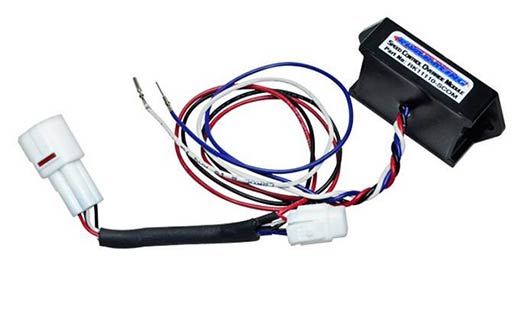
In With the Good Air
Another affordable and relatively easy installation to uptick the performance of your personal watercraft is an improved intake system.
While your stock system is designed for performance, it is also intended to reduce noise. Most make the mistake that engine noise is primarily exhausting, but it’s not so. The velocity at which your powerplant sucks air into the intake can make a noticeable difference in the sound output.
Thus, be aware that while the following will make your PWC run better, faster, and likely deliver not only greater performance but also better fuel economy, it will be a bit (or possibly a lot) louder.
Again, we’ll turn our attention to kits available from the aftermarket’s premier supplier, Riva Racing.
A Riva fresh air intake delivers greater amounts of cooler air to your combustion chambers.
The most affordable and easiest to install of these is simply an oversized screen-type flame arrestor, actually produced by K&N Filters, a company that has offered high-performance air cleaners for trucks, cars, and motorcycles since before I was even alive. My very first race bikes, way back when, were fitted with washable K&N filters, as were my dad’s. I’ve got one on my Toyota Tundra. They just work, far better than a replaceable air filter, and can be had for about 65 bucks through Riva.
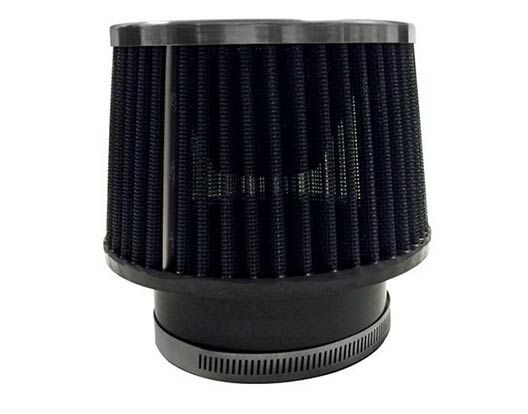
Be aware that you’ll also need to purchase a Riva pre-filter cover to fend off the intrusion of that pesky water you’re ripping around in. It is essentially a breathable fitted “plastic” bag of sorts, but I strongly recommend not running your personal watercraft without the additional protection. You’re looking at another 30 bucks or so.
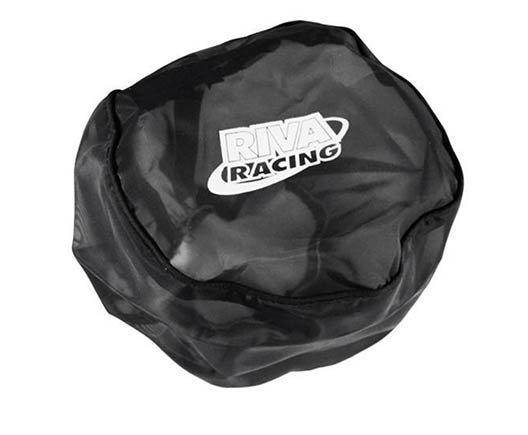
A mildly pricey step up from simply replacing your stock flame arrestor is replacing the entire intake with a cold-air type intake.
Riva’s dedicated systems run anywhere from $350-550, but will deliver noticeably enhanced acceleration as well as increase the capacity for rpm on the top end. Far less restrictive – and again, usually a good bit throatier – than a stock intake, the complete fresh air intake systems include a high-volume intake duct with flow-matched velocity stacks. This is likely the biggest bang for the buck in aftermarket hop-up choices.
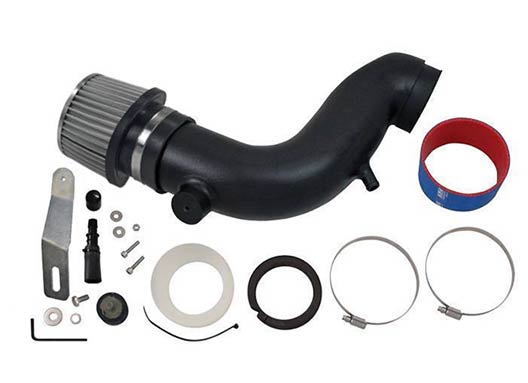
Gear it Up… or Down…
Many things, most things, have changed in the aftermarket performance market for personal watercraft, and exponential horsepower gains have become exponentially more expensive. If you want to delve into your engine’s internals to create more power, I will caution that you’ll need a wheelbarrow full of money.
But just as it was when modifying an engine was far more accessible to the masses and remained a do-it-yourself endeavor, for a relatively modest amount you can still move the power that you already have to where you want it most.
As stated above, factory installed impeller “gear ratios” are a compromise designed to work pretty well for most. And they do.
However, if you are primarily concerned with point-to-point acceleration or drag racing your buddy from a dead stop, a lower-pitched impeller will provide greater acceleration – albeit at the cost of some top speed.
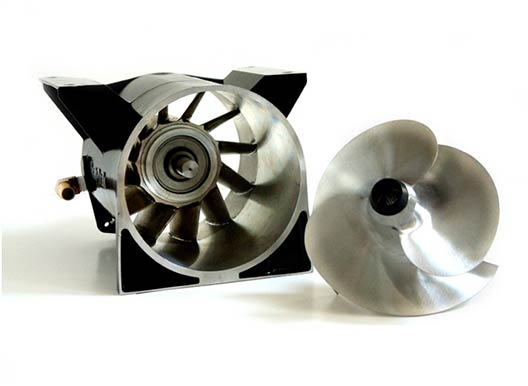
Conversely, your modern watercraft will certainly pull taller “gearing” with its stock horsepower output if top speed is your primary interest.
The two primary players in the impeller market have long been Skat-Trak and Solas, and from personal experience, I can recommend either with confidence.
Either company builds its variable pitch impellers from high-quality stainless steel.
Aftermarket impellers can be had for scarcely more than $200.
So how do you choose the right pitch, or pitch range?
First of all, you’ll want to research the pitch of your stock impeller and rather it is a straight rate – unlikely, these days – or already a variable pitch. Most OEM impellers are somewhere in the 15-20 pitch range.
Remember that the lower the number, the greater the acceleration factor. But also be wary of dropping the pitch number to the point where you might be needlessly over-revving your machine at higher cruising speeds. Generally speaking, every point of the pitch will raise or lower your engine’s rpm level by 4-500 rpm.
Thus, going from a 15-20 impeller to a 14-19 will accentuate acceleration while remaining well within the safe operating range of your engine. Conversely, moving to a 16-21 will cost you a little off the bottom, but might deliver an extra 2 or 4 mph on top – just enough to finally outrace your buddy across the lake.
Bottom Line
Frankly, in the modern era, if performance is one of your primary pursuits in riding Jet Ski the best solution is to buck up at the dealership and buy the fastest boat you can afford. The above modifications can further increase your performance without breaking the bank.
Sadly, however, the days of spending a thousand bucks and gaining 20 horses are long gone. Today’s personal watercraft are simply too sophisticated to improve in any substantial way without compromising both reliability and your bank account.
But isn’t that a good thing?
